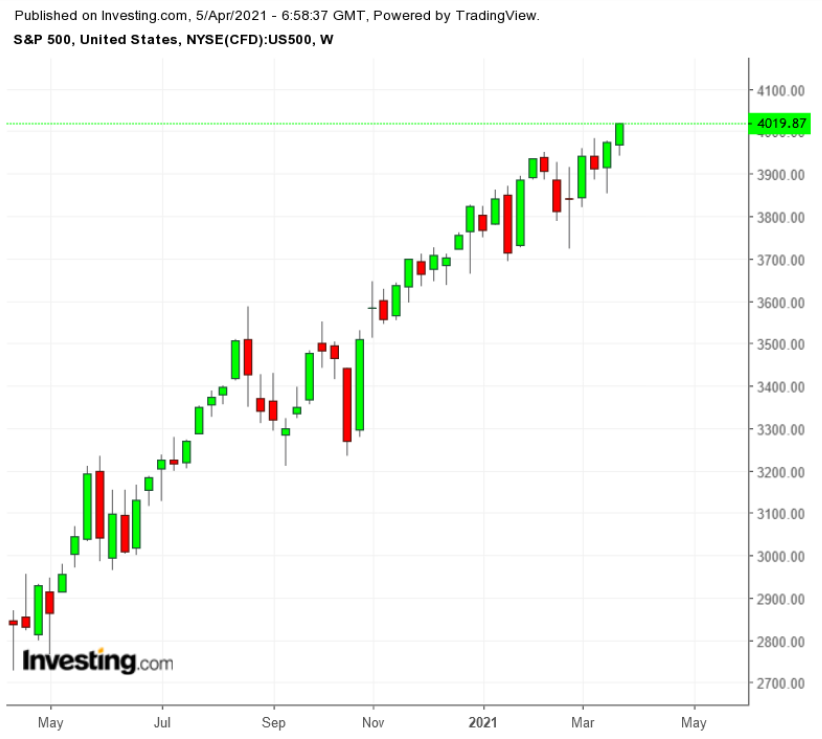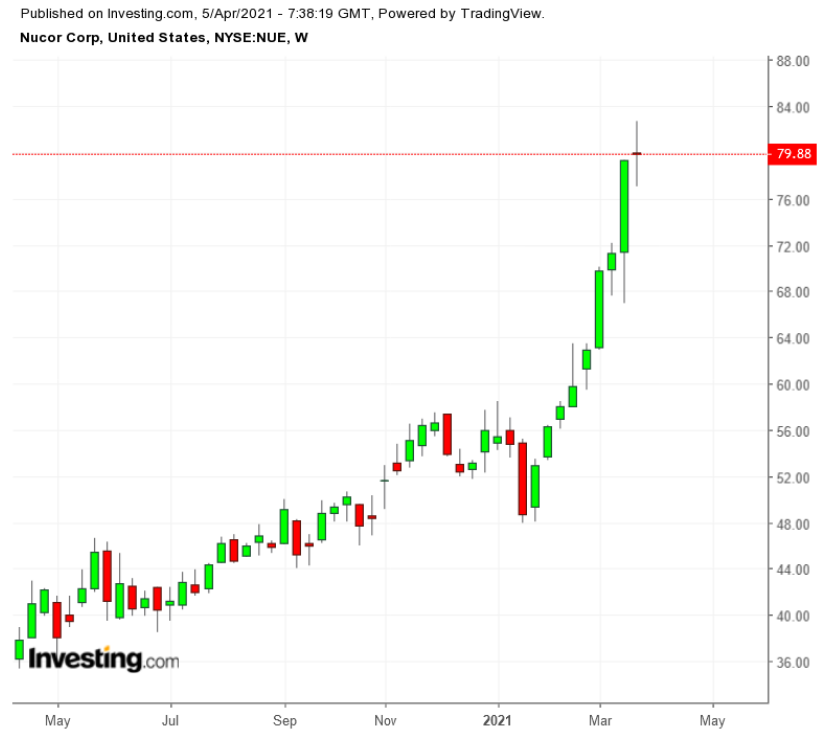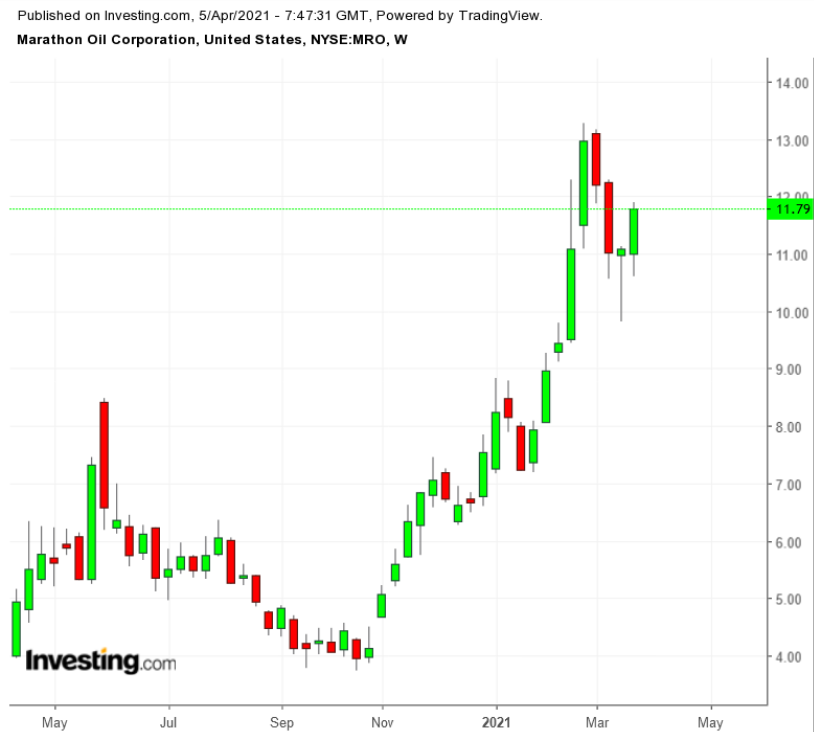Stocks delivered decent results in March and the first quarter. That's the bottom line.
The S&P 500 and Dow Jones Industrials enjoyed their best returns for the month of March since 2016.
And based on the S&P 500's show-stopping 4,000 on Thursday to close out the week and start the second quarter, and Friday's hugely bullish reports on jobs along with Tesla's (NASDAQ:TSLA) better-than-expected first-quarter production, stocks stand a good chance of opening higher on Monday at the very least.

They could also continue moving higher unless the COVID-19 virus derails the economic recovery that Wall Street is anticipating.
Gains for the major US indices during the first quarter—7.8% for the Dow, 5.8% for the S&P 500 and 2.8% for the NASDAQ Composite—were a vast improvement over the calamity the benchmarks endured during 2020's first quarter. At that time, the Dow fell 23.2%, the S&P 500 dropped 20% and the NASDAQ slumped by 14.2%. However, the same indices failed to match the impressive returns made during the fourth quarter of 2020.
As of Wednesday's close, the S&P was up 81.3% from its Mar. 23, 2020, low—and 487.3% from its close on Mar. 9, 2009, its lowest finish during the 2008-09 financial crisis.
Still, despite the monthly and quarterly gains, investors had plenty to fret about. Interest rates jumped, relatively speaking, from last year's lows. And inflation was a word one heard regularly.
As well, there is an ongoing shortage of semiconductors that threatens the production of everything from computers and mobile phones to cars and trucks. Plus, volatility was rampant for no apparent reason.
Lastly, there was good and bad news about the COVID-19 virus itself. Millions of people are getting vaccinated in the United States, Canada and Western Europe. But variants of the original virus are spreading. The spread forced Ontario provincial officials to order a partial lockdown. It is not clear if the vaccines now available work against the various strains.
Here is a deeper look at the results for March and what they mean:
Fed And U.S. Treasury Alive And Well...For Now
The Federal Reserve, as well as the U.S. Treasury, have driven the market recovery from when the pandemic hit.
During March 2020, as the global coronavirus outbreak accelerated, Fed Chairman Jerome Powell vowed the central bank would do whatever it could to stabilize the economy and financial markets and get a jumpstart on an economic recovery.
The Treasury, under then-Secretary Steve Mnuchin and now, Janet Yellen, have been happy to flood the economy with cash.
A year later, stocks are at or near record highs. Net new highs (the difference between 52-week highs and lows and an indicator of market strength) have been positive since early November—meaning the market is bullish.
Stocks That Will Lead The Physical Recovery Driving The Market
The top S&P 500 stock in March (and sixth overall for the quarter): Nucor (NYSE:NUE), the largest U.S. steel maker, was up 34.2% for the month and 50.9% in the quarter.

Construction of all sorts, particularly after last week's announcement of the $2 trillion Biden infrastructure initiative, is expected over the next 18 months.
Many investors are sure the recovery has started. "There are enormous expectations for the second half of the year," says Howard Silverblatt, senior index analyst with S&P Dow Jones Indices, the company that manages the Dow Jones and Standard & Poor's indexes.
And it will touch many sectors. Housing for one. Lennar (NYSE:LEN), which builds homes in 22 states, was up 22% in March (fifth overall in the S&P 500) and nearly 33% in the first quarter, good for 38th place.
That means we'll also need hardware. Lowe's (NYSE:LOW) and Home Depot (NYSE:HD), up 19.1% and 18.2% respectively in March, were 12th and 14th among S&P 500 stocks. Home Depot was the second-best performer in the Dow in March and 11th for the blue chips in the quarter.
Many investors believe mass-market consumers might also be on the hunt for a new vehicle in, say, the next 6 to 12 months. So, they bought into Ford (NYSE:F) and General Motors (NYSE:GM), which were up 39.4% and 38%, respectively, in the quarter.
And of course, Wall Street knows people who've been homebound and under lockdown during the pandemic want to travel. As such, airline stocks were winners in March and for the quarter. Boeing (NYSE:BA) was the top Dow performer in March, up 20.1%. American Airlines Group (NASDAQ:AAL) was the top S&P 500 industrial stock in the quarter, and Alaska Air Group (NYSE:ALK), United Airlines Holdings (NASDAQ:UAL) and Southwest Airlines (NYSE:LUV) were all among the top 10 of the 73-stock group for the month.
Airlines also led the Dow Jones Transportation Index for the quarter.
Biggest Winners: Energy Stocks
Because U.S. stocks are in stimulus-fed recovery market, the most powerful sectors this year have been energy, financials and industrials, and stocks in these sectors should continue to hold their own.

Marathon Oil (NYSE:MRO), the big oil and gas exploration-and-production company, was the second best S&P 500 performer for the quarter, up 60.1%. Occidental Petroleum (NYSE:OXY) and Diamondback Energy (NASDAQ:FANG) were among the top five S&P stocks in the quarter.
The obvious catalyst was higher oil prices. West Texas intermediate, the benchmark U.S. crude, was up 21.9% to $59.16 a barrel in the quarter. From its $19.27-a-barrel intraday low in March 2020, WTI has soared 207%.
The big rally was due in part to hopes for a recovery, but also importantly, to moves by the Organization of Petroleum Exporting Countries, and allies like Russia to cut production and push global prices. Recently, the cartel decided to expand permitted output because many OPEC members need the cash. So, oil prices moved lower.
Don't Forget Financials And Industrials
Banks and other financial companies also rallied strongly in the quarter because of the recovery theme. Investment managers, banks, brokers, life and property-casualty insurers led the financial sector because investors know they all have more pricing power with rates rising and funding costs low.
Invesco (NYSE:IVZ) led the sector in the quarter, up 44.7%. Wells Fargo (NYSE:WFC), which has struggled in recent years because of management problems, added 29.5% in the quarter and 8% in March.
While airlines led the industrial sector, Generac Holdings (NYSE:GNRC), which makes home backup generators, farm-equipment giant Deere (DE) and industrial machine giant Caterpillar (NYSE:CAT) were among the top 11 industrial performers, up 44%, 39.1% and 27.4%, respectively.
Caterpillar was also the third-best Dow performer in the quarter, after Walgreens Boots Alliance (NASDAQ:WBA)) and Intel (NASDAQ:INTC).
What Happened To Tech Stocks?
The problem was two-fold. First, the chip shortage hit companies across the spectrum—from Apple (NASDAQ:AAPL) and its latest iPhone to Samsung (OTC:SSNLF) to Whirlpool (NYSE:WHR) to Ford.
Without the chips needed to monitor what's going on inside an automobile, some car makers had to halt production. Nio (NYSE:NIO), the Chinese electric-vehicle maker, was forced to shut down a factory for five days last week, then warned it won't be able to meet its first-quarter production guidance.
The second problem was less specific: tech shares (including Amazon (NASDAQ:AMZN) and Tesla just got pricey in the second half of 2020 because demand for electronics to enable stay-at-home work exploded. But in 2021, companies couldn't make sales and a number of tech shares stalled or fell back.
And, with a recovery coming into focus, many investors saw better opportunities and sold out in order to get in to non-tech sectors. Hence Tesla fell nearly 15% in February and another 1.1% in March—after rising 12.5% in January and 743% in 2020.
The counterpoint to all was Intel, which added 5.3% in March and 28% for the quarter on investor hopes that Pat Gelsinger, who became CEO in mid-February, can make the chip giant more nimble. It's a formidable task: manufacturing delays need to be fixed, among other problems in order to regain market share versus rivals such as Advanced Micro Devices. (NASDAQ:AMD).
Even AMD wasn't immune to selling. Shares, up nearly 100% in 2020 (and 11.9% in the fourth quarter), fell 7.1% in March and 14.4% for the quarter.
Are Higher Rates A Threat To Markets And The Economy?
Not yet. Otherwise, one would see the red-hot housing market start to cool off. Home prices in major markets have gone up more than 15% or so in a year. Low rates are the fuel for higher prices.
If there is a threat, it will mean the Federal Reserve is forced to abandon its stated plan of not raising rates until inflation tops two percent (as measured by price changes in the government's Personal Consumption Expenditures Price Index for a sustained amount of time. The index in February was up 1.6% year-over-year. It hasn't topped two percent in at least two years.
Rates are still historically low. The 10-year Treasury yield was at 1.75% on Mar. 31, up 90% for the year since Dec. 31 but still down from 1.92% at the end of 2019 before the virus hit. The benchmark's yield ticked up in non-regular trading on Friday and may move higher this week.
Concern might explode If the 10-year yield tops 2% or even 2.5%—but that's a level not seen in about two years.
Some Wacky And Scary Trading Too
Look no further for extreme volatility than GameStop (NYSE:GME), the video-game retailer which ended March up 86.6% after FALLING 68.7% in February.

For the quarter, the stock was up 907.5%. Revenue in fiscal 2019 was down 21% and has been falling. The company is getting rid of stores, planning to market products and games online.
The wild speculation has drawn thousands of younger, would-be retail investors into the stock and others as well. But its extreme volatility has wiped out some positions. And S&P's Howard Silverblatt speaks for many on Wall Street who worry this sort of trading is a sign of a market bubble.
Still, MarketWatch reported last week that Keith Gill, the best-known speculator in the stock, has made a profit of perhaps $25 million from his trading.
A more subtle and possibly troubling event came when some of the world's biggest banks found themselves facing serious losses after financing huge bets made by Archegos Capital Management, former hedge fund manager Bill Hwang's family office that duly went bad.
Shares of Viacom (NASDAQ:VIAC) fell 30% and Discovery Communications (NASDAQ:DISCA) dropped 18% in March after banks liquidated Archegos's positions. The problem was Hwang's $10 billion had been assembled under just about all financial institution radar, leading some to wonder if another shoe is soon to drop.
Risks Going Forward
The market could well move higher thanks to better jobs numbers, more consumer consumption and the like.
But that assumes:
- The recovery gains strength, a possibility after Friday's robust jobs report.
- The pandemic is mostly under control.
- Interest rates do not shoot so high that the housing market softens. Watch to see the market reaction if the 10-year Treasury yield tops 2%.
- The dollar stabilizes. It was up nearly 4% in the first quarter as foreign investors used the currency to invest in the recovery. But if the USD rises too quickly problems could arise because that makes imports cheaper compared to the cost of U.S.-made goods.
- A solution is found to alleviate the semiconductor shortage. President Biden and his staff will meet with chip-company executives and others on Apr. 12 to discuss the issue.
- There are no more blockages of major waterways around the world. The jam in the Suez Canal by the giant container ship Ever Given was difficult enough.
- Geopolitical hazards don't escalate: markets so far have not paid much attention to the saber-rattling over Taiwan coming from China and over Ukraine by Russia.
